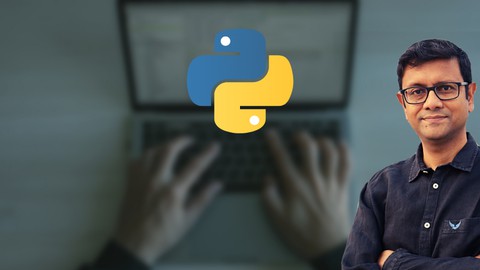
Python 3 Masterclass step by step with coding exercises.
Python 3 Masterclass step by step with coding exercises., available at $69.99, has an average rating of 4.95, with 122 lectures, 31 quizzes, based on 199 reviews, and has 1022 subscribers.
You will learn about Complete command over Python language. Basics of Python Control structures – loops, if-elif-else, break, continue Writing functions in Python, understanding Parameters string List Set Dictionary tuple random module Exception handling using try-except block. Command line arguments File handling in detail including reading and writing of csv files using csv module Class, Objects, magic methods. This course is ideal for individuals who are Anyone who wants to start learning Python language. or Python is required for Data Science or Machine Learning, if you learn Python language, it will be helpful for exploring those booming arena. or If you want to become a web application developer then you can start learning Python language. It is particularly useful for Anyone who wants to start learning Python language. or Python is required for Data Science or Machine Learning, if you learn Python language, it will be helpful for exploring those booming arena. or If you want to become a web application developer then you can start learning Python language.
Enroll now: Python 3 Masterclass step by step with coding exercises.
Summary
Title: Python 3 Masterclass step by step with coding exercises.
Price: $69.99
Average Rating: 4.95
Number of Lectures: 122
Number of Quizzes: 31
Number of Published Lectures: 122
Number of Published Quizzes: 31
Number of Curriculum Items: 153
Number of Published Curriculum Objects: 153
Original Price: $199.99
Quality Status: approved
Status: Live
What You Will Learn
- Complete command over Python language.
- Basics of Python
- Control structures – loops, if-elif-else, break, continue
- Writing functions in Python, understanding Parameters
- string
- List
- Set
- Dictionary
- tuple
- random module
- Exception handling using try-except block.
- Command line arguments
- File handling in detail including reading and writing of csv files using csv module
- Class, Objects, magic methods.
Who Should Attend
- Anyone who wants to start learning Python language.
- Python is required for Data Science or Machine Learning, if you learn Python language, it will be helpful for exploring those booming arena.
- If you want to become a web application developer then you can start learning Python language.
Target Audiences
- Anyone who wants to start learning Python language.
- Python is required for Data Science or Machine Learning, if you learn Python language, it will be helpful for exploring those booming arena.
- If you want to become a web application developer then you can start learning Python language.
This course will help you to learn Python 3 step by step from beginning to expert level. Undoubtedly, Python is the most in-demand language. It is used for Data Science and analytics, Machine Learning, Web Programming.
This course aims to teach the Python language in depth to the students, the instructor explains everything from grounds up so that student could learn the basics with programming along with the Python language.
Clea instructions to download, install and configure Python is given at the beginning of the course, so that Students can smoothly install Python in their respective (Win or Mac) system.
Each section contains Coding exercises, these exercises are based on the topics, students will have to write the code practically as per the instructions within the provided editor to test their ability of acquired knowledge. Also there are quizzes to check the development of the students as they go through the course curriculum.
The syllabus of the course is based on the curriculum followed by the Universities across the globe in the graduate level engineering or computer application courses.
If the students have further doubts they can always post in the Q/A section of the course.
The course starts with the fundamentals of Python including control structures, functions and fundamental data structures and then moves towards the advance topics.
Course Curriculum
Chapter 1: Introduction
Lecture 1: Introduction
Chapter 2: Downloading and Installing of required software
Lecture 1: Install Anaconda for Windows.
Lecture 2: Installing Anaconda for Mac OS.
Lecture 3: Learn how you can use Python IDLE for writing and executing your Python script.
Lecture 4: Write Python in text editor and execute from terminal.
Lecture 5: Using PyCharm – See how you can download install and use PyCharm IDE for Python.
Lecture 6: How to use Spyder IDE – inbuilt within Anaconda, no need to download.
Lecture 7: How to use Jupyter notebook for writing and executing Python script.
Chapter 3: Basics you always need to know – Do not skip this section if you are novice.
Lecture 1: How to print string into console – the one and only Python 3 print function.
Lecture 2: Variables in Python – names are just references, don't miss this concept.
Lecture 3: Rules for providing name for variables.
Lecture 4: Difference between a "Program" and "Script".
Lecture 5: Strings are everywhere – Understand the basics of Python string.
Lecture 6: Some more features of int function-you can convert binary, octal or hex strings.
Lecture 7: Taking input from console – input function.
Lecture 8: How to write comments in Python script.
Lecture 9: Arithmetic Operators in Python – Do some Maths!
Lecture 10: Python console on Pycharm, the assignment operator in Python, lvalue, rvalue
Lecture 11: Relational operators in Python.
Lecture 12: Logical operators in Python.
Chapter 4: Take decision – follow a branch – Use if-else
Lecture 1: Introduction to branching using if-else: Understand the basics first.
Lecture 2: Using elif block – testing condition in the else part with elif.
Lecture 3: One line alternative to if-else or if-elif statememts.
Lecture 4: Branching in action – Check if a given year is Leap year.
Lecture 5: Another programming example: Calculate Income Tax.
Chapter 5: Loop – iterating over a section of code again and again.
Lecture 1: Why we need loop – introduction, then while loop in Python.
Lecture 2: Example program using while loop.
Lecture 3: Another good programming example with while loop – find the factors of a number.
Lecture 4: The smart looking for loop and range function.
Lecture 5: Iterating through a string – printing all possible association.
Lecture 6: Printing Fibonacci Sequence.
Lecture 7: Using break to get out of a loop.
Lecture 8: The continue keyword -skip the rest of the current iteration and go to the next
Lecture 9: else block with loop – what does it mean? This is something new in Python.
Lecture 10: Print a pattern using nested loop – a loop inside of another.
Chapter 6: Python list – The mutable linear container.
Lecture 1: Introduction to Python List.
Lecture 2: Unpacking of list elements.
Lecture 3: List slicing – take out a portion of list using robust slicing technique.
Lecture 4: Important list methods – Part 1
Lecture 5: Important list methods – Part 2
Lecture 6: Enumerate function
Lecture 7: zip function to combine corresponding elements of different lists.
Chapter 7: Python string – all you need to know about Python string.
Lecture 1: String slicing
Lecture 2: Formatting a string using format method.
Lecture 3: Output data in tabular format using the format method.
Lecture 4: Formatting using fstring – a new and better way.
Lecture 5: Important string methods – Part 1
Lecture 6: Important string methods – Part 2
Chapter 8: Python tuple – Immutable linear container.
Lecture 1: Introduction to tuple.
Lecture 2: tuple to list and vice-versa: Sometimes we need this.
Lecture 3: More tuple operations.
Chapter 9: Python set – Pythonian way to represent set of Mathematics.
Lecture 1: Introduction and basic idea of Python set.
Lecture 2: Understanding of set continues…
Lecture 3: More set operations – Part 1
Lecture 4: More set operations – Part 2
Chapter 10: Python dictionary – associative container in Python.
Lecture 1: Introduction and basic idea of Python Dictionary.
Lecture 2: Important dictionary operations – Part 1.
Lecture 3: Important dictionary operations – Part 2.
Lecture 4: Formatting a dictionary using both format and fstring.
Chapter 11: List comprehension – a powerful tool to create a list.
Lecture 1: Introduction to List Comprehension.
Instructors
-
Shibaji Paul
Programming Instructor with 16+ years of experience
Rating Distribution
- 1 stars: 0 votes
- 2 stars: 5 votes
- 3 stars: 10 votes
- 4 stars: 61 votes
- 5 stars: 123 votes
Frequently Asked Questions
How long do I have access to the course materials?
You can view and review the lecture materials indefinitely, like an on-demand channel.
Can I take my courses with me wherever I go?
Definitely! If you have an internet connection, courses on Udemy are available on any device at any time. If you don’t have an internet connection, some instructors also let their students download course lectures. That’s up to the instructor though, so make sure you get on their good side!
You may also like
- Best Video Editing Courses to Learn in March 2025
- Best Music Production Courses to Learn in March 2025
- Best Animation Courses to Learn in March 2025
- Best Digital Illustration Courses to Learn in March 2025
- Best Renewable Energy Courses to Learn in March 2025
- Best Sustainable Living Courses to Learn in March 2025
- Best Ethical AI Courses to Learn in March 2025
- Best Cybersecurity Fundamentals Courses to Learn in March 2025
- Best Smart Home Technology Courses to Learn in March 2025
- Best Holistic Health Courses to Learn in March 2025
- Best Nutrition And Diet Planning Courses to Learn in March 2025
- Best Yoga Instruction Courses to Learn in March 2025
- Best Stress Management Courses to Learn in March 2025
- Best Mindfulness Meditation Courses to Learn in March 2025
- Best Life Coaching Courses to Learn in March 2025
- Best Career Development Courses to Learn in March 2025
- Best Relationship Building Courses to Learn in March 2025
- Best Parenting Skills Courses to Learn in March 2025
- Best Home Improvement Courses to Learn in March 2025
- Best Gardening Courses to Learn in March 2025






















